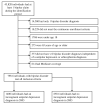Depression diagnoses following the identification of bipolar disorder: costly incongruent diagnoses
- PMID: 20525372
- PMCID: PMC2894758
- DOI: 10.1186/1471-244X-10-39
Depression diagnoses following the identification of bipolar disorder: costly incongruent diagnoses
Abstract
Background: Previous research has documented that the symptoms of bipolar disorder are often mistaken for unipolar depression prior to a patient's first bipolar diagnosis. The assumption has been that once a patient receives a bipolar diagnosis they will no longer be given a misdiagnosis of depression. The objectives of this study were 1) to assess the rate of subsequent unipolar depression diagnosis in individuals with a history of bipolar disorder and 2) to assess the increased cost associated with this potential misdiagnosis.
Methods: This study utilized a retrospective cohort design using administrative claims data from 2002 and 2003. Patient inclusion criteria for the study were 1) at least 2 bipolar diagnoses in 2002, 2) continuous enrollment during 2002 and 2003, 3) a pharmacy benefit, and 4) age 18 to 64. Patients with at least 2 unipolar depression diagnoses in 2003 were categorized as having an incongruent diagnosis of unipolar depression. We used propensity scoring to control for selection bias. Utilization was evaluated using negative binomial models. We evaluated cost differences between patient cohorts using generalized linear models.
Results: Of the 7981 patients who met all inclusion criteria for the analysis, 17.5% (1400) had an incongruent depression diagnosis (IDD). After controlling for background differences, individuals who received an IDD had higher rates of inpatient and outpatient psychiatric utilization and cost, on average, an additional $1641 per year compared to individuals without an IDD.
Conclusions: A strikingly high proportion of bipolar patients are given the differential diagnosis of unipolar depression after being identified as having bipolar disorder. Individuals with an IDD had increased acute psychiatric care services, suggesting higher levels of relapses, and were at risk for inappropriate treatment, as antidepressant therapy without a concomitant mood-stabilizing medication is contraindicated in bipolar disorder. Further prospective research is needed to validate the findings from this retrospective administrative claims-based analysis.
Figures
References
-
- Kessler RC, McGonagle KA, Zhao S, Nelson CB, Hughes M, Eshleman S, Wittchen HU, Kendler KS. Lifetime and 12-month prevalence of DSM-III-R psychiatric disorders in the United States. Results from the National Comorbidity Survey. Arch Gen Psychiatry. 1994;51:8–19. - PubMed
-
- Weissman MM, Bland RC, Canino GJ, Faravelli C, Greenwald S, Hwu HG, Joyce PR, Karam EG, Lee CK, Lellouch J, Lépine JP, Newman SC, Rubio-Stipec M, Wells JE, Wickramaratne PJ, Wittchen H, Yeh EK. Cross-national epidemiology of major depression and bipolar disorder. JAMA. 1996;276:293–299. doi: 10.1001/jama.276.4.293. - DOI - PubMed
-
- Unutzer J, Simon G, Pabiniak C, Bond K, Katon W. The treated prevalence of bipolar disorder in a large staff-model HMO. Psychiatr Serv. 1998;49:1072–1078. - PubMed
Publication types
MeSH terms
Substances
LinkOut - more resources
Full Text Sources
Medical
Miscellaneous



